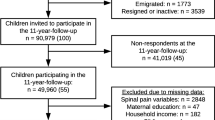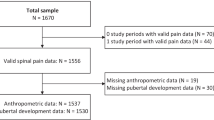Abstract
Purpose
Non-specific spinal pain can occur at all ages and current evidence suggests that pediatric non-specific spinal pain is predictive for adult spinal conditions. A 5-year long, prospective cohort study was conducted to identify the lifestyle and environmental factors leading to non-specific spinal pain in childhood.
Materials and methods
Data were collected from school children aged 7–16 years, who were randomly selected from three different geographic regions in Hungary. The risk factors were measured with a newly developed patient-reported questionnaire (PRQ). The quality of the instrument was assessed by the reliability with the test–retest method. Test (N = 952) and validity (N = 897) datasets were randomly formed. Risk factors were identified with uni- and multivariate logistic regression models and the predictive performance of the final model was evaluated using the receiver operating characteristic (ROC) method.
Results
The final model was built up by seven risk factors for spinal pain for days; age > 12 years, learning or watching TV for more than 2 h/day, uncomfortable school-desk, sleeping problems, general discomfort and positive familiar medical history (χ2 = 101.07; df = 8; p < 0.001). The probabilistic performance was confirmed with ROC analysis on the test and validation cohorts (AUC = 0.76; 0.71). A simplified risk scoring system showed increasing possibility for non-specific spinal pain depending on the number of the identified risk factors (χ2 = 65.0; df = 4; p < 0.001).
Conclusion
Seven significant risk factors of non-specific spinal pain in childhood were identified using the new, easy to use and reliable PRQ which makes it possible to stratify the children according to their individual risk.
Graphical abstract
These slides can be retrieved under Electronic Supplementary Material.



Similar content being viewed by others
References
Murray CJ, Barber RM, Foreman KJ, Abbasoglu Ozgoren A, Abd-Allah F, Abera SF et al (2015) Global, regional, and national disability-adjusted life years (DALYs) for 306 diseases and injuries and healthy life expectancy (HALE) for 188 countries, 1990–2013: quantifying the epidemiological transition. Lancet 386(10009):2145–2191. https://doi.org/10.1016/S0140-6736(15)61340-X
Waddell G (1987) 1987 Volvo award in clinical sciences. A new clinical model for the treatment of low-back pain. Spine (Phila Pa 1976) 12(7):632–644
Hoy D, Brooks P, Blyth F, Buchbinder R (2010) The epidemiology of low back pain. Best Pract Res Clin Rheumatol 24(6):769–781. https://doi.org/10.1016/j.berh.2010.10.002
Burton AK, Balague F, Cardon G, Eriksen HR, Henrotin Y, Lahad A, Leclerc A, Muller G, van der Beek AJ, Pain CBWGoGfPiLB (2006) European guidelines for prevention in low back pain: November 2004. Eur Spine J 15(Suppl 2):136–168. https://doi.org/10.1007/s00586-006-1070-3
Childs JD, Cleland JA, Elliott JM, Teyhen DS, Wainner RS, Whitman JM, Sopky BJ, Godges JJ, Flynn TW, American Physical Therapy A (2008) Neck pain: clinical practice guidelines linked to the international classification of functioning, disability, and health from the orthopedic section of the American physical therapy association. J Orthop Sports Phys Ther 38(9):A1–A34. https://doi.org/10.2519/jospt.2008.0303
Fejer R, Kyvik KO, Hartvigsen J (2006) The prevalence of neck pain in the world population: a systematic critical review of the literature. Eur Spine J 15(6):834–848. https://doi.org/10.1007/s00586-004-0864-4
Jeffries LJ, Milanese SF, Grimmer-Somers KA (2007) Epidemiology of adolescent spinal pain: a systematic overview of the research literature. Spine (Phila Pa 1976) 32(23):2630–2637. https://doi.org/10.1097/brs.0b013e318158d70b
Kjaer P, Wedderkopp N, Korsholm L, Leboeuf-Yde C (2011) Prevalence and tracking of back pain from childhood to adolescence. BMC Musculoskelet Disord 12:98. https://doi.org/10.1186/1471-2474-12-98
Aartun E, Hartvigsen J, Wedderkopp N, Hestbaek L (2014) Spinal pain in adolescents: prevalence, incidence, and course: a school-based two-year prospective cohort study in 1,300 Danes aged 11–13. BMC Musculoskelet Disord 15:187. https://doi.org/10.1186/1471-2474-15-187
Jones MA, Stratton G, Reilly T, Unnithan VB (2004) A school-based survey of recurrent non-specific low-back pain prevalence and consequences in children. Health Educ Res 19(3):284–289. https://doi.org/10.1093/her/cyg025
Wirth B, Humphreys BK (2015) Pain characteristics of adolescent spinal pain. BMC Pediatr 15:42. https://doi.org/10.1186/s12887-015-0344-5
Hestbaek L, Leboeuf-Yde C, Kyvik KO, Manniche C (2006) The course of low back pain from adolescence to adulthood: eight-year follow-up of 9600 twins. Spine (Phila Pa 1976) 31(4):468–472. https://doi.org/10.1097/01.brs.0000199958.04073.d9
Hestbaek L, Leboeuf-Yde C, Kyvik KO (2006) Is comorbidity in adolescence a predictor for adult low back pain? A prospective study of a young population. BMC Musculoskelet Disord 7:29. https://doi.org/10.1186/1471-2474-7-29
Balague F, Skovron ML, Nordin M, Dutoit G, Pol LR, Waldburger M (1995) Low back pain in schoolchildren. A study of familial and psychological factors. Spine (Phila Pa 1976) 20(11):1265–1270
Dockrell S, Simms C, Blake C (2015) Schoolbag carriage and schoolbag-related musculoskeletal discomfort among primary school children. Appl Ergon 51:281–290. https://doi.org/10.1016/j.apergo.2015.05.009
Jones GT, Watson KD, Silman AJ, Symmons DP, Macfarlane GJ (2003) Predictors of low back pain in British schoolchildren: a population-based prospective cohort study. Pediatrics 111(4 Pt 1):822–828
Kovacs FM, Gestoso M, Gil del Real MT, López J, Mufraggi N, Ignacio Méndez J (2003) Risk factors for non-specific low back pain in schoolchildren and their parents: a population based study. Pain 103(3):259–268. https://doi.org/10.1016/s0304-3959(02)00454-2
Wilson IB (1995) Linking clinical variables with health-related quality of life. A conceptual model of patient outcomes. J Am Med Assoc 273(1):59–65. https://doi.org/10.1001/jama.273.1.59
Terwee CB, Bot SD, de Boer MR, van der Windt DA, Knol DL, Dekker J, Bouter LM, de Vet HC (2007) Quality criteria were proposed for measurement properties of health status questionnaires. J Clin Epidemiol 60(1):34–42. https://doi.org/10.1016/j.jclinepi.2006.03.012
Landis JR, Koch GG (1977) The measurement of observer agreement for categorical data. Biometrics 33(1):159–174
Peduzzi P, Concato J, Kemper E, Holford TR, Feinstein AR (1996) A simulation study of the number of events per variable in logistic regression analysis. J Clin Epidemiol 49(12):1373–1379
Dissing KB, Hestbaek L, Hartvigsen J, Williams C, Kamper S, Boyle E, Wedderkopp N (2017) Spinal pain in Danish school children—how often and how long? The CHAMPS Study-DK. BMC Musculoskelet Disord 18(1):67. https://doi.org/10.1186/s12891-017-1424-5
Lazary A, Szoverfi Z, Szita J, Somhegyi A, Kumin M, Varga PP (2014) Primary prevention of disc degeneration-related symptoms. Eur Spine J 23(Suppl 3):S385–S393. https://doi.org/10.1007/s00586-013-3069-x
Trevelyan FC, Legg SJ (2006) Back pain in school children–where to from here? Appl Ergon 37(1):45–54. https://doi.org/10.1016/j.apergo.2004.02.008
Calvo-Munoz I, Gomez-Conesa A, Sanchez-Meca J (2013) Prevalence of low back pain in children and adolescents: a meta-analysis. BMC Pediatr 13:14. https://doi.org/10.1186/1471-2431-13-14
Olsen TL, Anderson RL, Dearwater SR, Kriska AM, Cauley JA, Aaron DJ, LaPorte RE (1992) The epidemiology of low back pain in an adolescent population. Am J Public Health 82(4):606–608
MacDonald J, Stuart E, Rodenberg R (2017) Musculoskeletal low back pain in school-aged children: a review. JAMA Pediatr 171(3):280–287. https://doi.org/10.1001/jamapediatrics.2016.3334
Harreby M, Nygaard B, Jessen T, Larsen E, Storr-Paulsen A, Lindahl A, Fisker I, Laegaard E (1999) Risk factors for low back pain in a cohort of 1389 Danish school children: an epidemiologic study. Eur Spine J 8(6):444–450
Skoffer B, Foldspang A (2008) Physical activity and low-back pain in schoolchildren. Eur Spine J 17(3):373–379. https://doi.org/10.1007/s00586-007-0583-8
Billy GG, Lemieux SK, Chow MX (2014) Changes in lumbar disk morphology associated with prolonged sitting assessed by magnetic resonance imaging. PM R 6(9):790–795. https://doi.org/10.1016/j.pmrj.2014.02.014
Trigueiro MJ, Massada L, Garganta R (2013) Back pain in Portuguese schoolchildren: prevalence and risk factors. Eur J Public Health 23(3):499–503. https://doi.org/10.1093/eurpub/cks105
Limon S, Valinsky LJ, Ben-Shalom Y (2004) Children at risk: risk factors for low back pain in the elementary school environment. Spine (Phila Pa 1976) 29(6):697–702
Watson KD, Papageorgiou AC, Jones GT, Taylor S, Symmons DP, Silman AJ, Macfarlane GJ (2002) Low back pain in schoolchildren: occurrence and characteristics. Pain 97(1–2):87–92
Erne C, Elfering A (2011) Low back pain at school: unique risk deriving from unsatisfactory grade in maths and school-type recommendation. Eur Spine J 20(12):2126–2133. https://doi.org/10.1007/s00586-011-1803-9
Wirth B, Knecht C, Humphreys K (2013) Spine Day 2012: spinal pain in Swiss school children- epidemiology and risk factors. BMC Pediatr 13:159. https://doi.org/10.1186/1471-2431-13-159
Hoftun GB, Romundstad PR, Rygg M (2012) Factors associated with adolescent chronic non-specific pain, chronic multisite pain, and chronic pain with high disability: the Young-HUNT Study 2008. J Pain 13(9):874–883. https://doi.org/10.1016/j.jpain.2012.06.001
Acknowledgements
The authors would like to thank the school teachers for their help in subject recruitment. We are grateful to Mária Tóth and Rita Füzi from the National Public Health and Medical Officer Services for their valuable support during the project. We also thank Jessica Böröcz Quittard for providing English language corrections.
Funding
The research leading to these results received funding from the European Community’s GENODISC Programme under grant agreement no. HEALTH-F2-2008-201626.
Author information
Authors and Affiliations
Corresponding author
Ethics declarations
Conflict of interest
None of the authors have any potential conflict of interest.
Ethical approval
The study was approved by Hungary’s Scientific and Research Ethics Committee of the Medical Research Council (431/PI/2007).
Informed consent
All participants’ parents/legal guardians received study information and signed an informed consent form.
Electronic supplementary material
Below is the link to the electronic supplementary material.
Rights and permissions
About this article
Cite this article
Szita, J., Boja, S., Szilagyi, A. et al. Risk factors of non-specific spinal pain in childhood. Eur Spine J 27, 1119–1126 (2018). https://doi.org/10.1007/s00586-018-5516-1
Received:
Revised:
Accepted:
Published:
Issue Date:
DOI: https://doi.org/10.1007/s00586-018-5516-1




